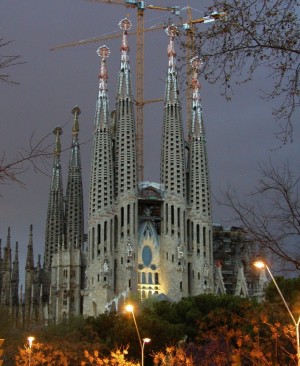|
|||||||||||||||||||||||
|
|||||||||||||||||||||||
The Government deceives Unesco: there are alternative routes for the AVE train |
|
The international body, thanks to reports from the Ministry of Culture and Public Works, states that there is no possible alternative route and includes some recommendationsThe Unesco World Heritage Committee is currently working on an analysis of the viability and impact of the AVE route project which will pass close to the monument of the Sagrada Familia temple, by calle Mallorca. The document concludes that there is no possible alternative route and considers “satisfactory” the preventative and supervisory measures proposed by the Ministry of Culture. 
Unesco suggested at the time that the possibility of an alternative route should be studied and, in the event it were not possible, that all the technical guarantees that the structure of the building, begun by the modernist architect Antonio Gaudi and continued after his death in 1926, needed be given. The conclusions of the report are surprising because there are alternative routes, of the two of them, one had already been previously proposed by the very Ministry of Public Works. The report includes recommendations such as the construction of a great screen of concrete columns of 240 metres length in order to protect the Gloria facade on calle Mallorca and the installation of a complex system of sensors to detect potential movement of the ground upon which the Temple sits. The alternative routesUnesco had reached the conclusion that there was no alternative route that wouldn’t pass by the side of the Sagrada Familia temple. The international body made this statement on the basis of the reports presented by the Ministry of Culture and Public Works who provided the details of the building works, said documents deny the possibility of an alternative route. .jpg)
However, the Ministry of Public Works itself some time ago presented an alternative route for the AVE along the Coast which would enter the city through the centre of Llobregat and would lead into the Zona Franca to thereafter continue along the Barcelona coastline up to the Las Glorias square and would conclude at the Sagrera station. This proposal was well received by the Town Council of Barcelona and by different associations such as the Plataforma AVE por el Litoral (Neighbourhood Association for the AVE along the Coastline) which sees this as a more coherent proposal. Another route which was proposed by the CiU (political party) back when it governed the Generalitat de Cataluña according to sources at the Plataforma Ave por el Litoral, is the one that would pass along Vallés, the price of which is 170 million euros, 9 million cheaper than the Eixample tunnel in Barcelona. The difference could be greater if one bears in mind that back then the increased cost of the construction of a protective screen for the Sagrada Familia was not included, nor were the indemnifications. This proposal was also given the nod by the Ministry of Public Works in 2007 but José Montilla and Jordi Hereu flatly rejected it. The Eixample route which passes through the city centre and which is ultimately the one to be executed has received a modification proposal on the part of the ERC group which would mean it would pass along calle Aragón instead of calle Mallorca, in so doing the route would be further from the Sagrada Familia and would pass along a road of more than 20 metres width, a proposal which without being ideal, would be more positive according to the Plataforma AVE por el Litoral. Sources at Plataforma AVE por el Litoral have taken the fact that the PSC are insisting on the AVE passing through the centre of Barcelona as the logical conclusion to the attitude in his day of the ex-mayor of Hospitalet and current Minister of Labour, Celestino Corbacho, who wanted the route to pass along the entrance to Sans to be able to benefit from some building works which would represent clear potential for property speculation and would block the railway corridor which passes through this area – already quite saturated with three suburban trains. The Plataforma AVE por el Litoral considered it illogical that the AVE should end up coming into the city when no European city has ever opted for that option as in being a high speed line logic dictates that trains not destined for Barcelona should not be obliged to pass through the city unnecessarily. The Eixample route finally decided upon by the Ministry of Public Works arrives at the Sans station and crosses Barcelona passing under the ground at calle Provenza and Mallorca until reaching the new Sagrera station in Meridiana. World heritage recognised by UNESCOUnesco included in 2005 the facade of the Nacimiento (Birth) and the Cripta de la Sagrada Familia (Crypt of the Sagrada Familia) in the world heritage catalogue, both executed by Gaudí. Previously, in 1984, the international body had already included the Palau Güell and the Casa Milà, works of the catalán architect, in its catalogue. In being buildings with the status of world heritage, the facade of the Nacimiento and the Cripta have been the subject of analysis and study on the part of the Unesco Comittee in Spain in order to reach a conclusion on the viability of the Ministry of Works project without affecting the monument. Source: forumlibertas.com | |
|
|